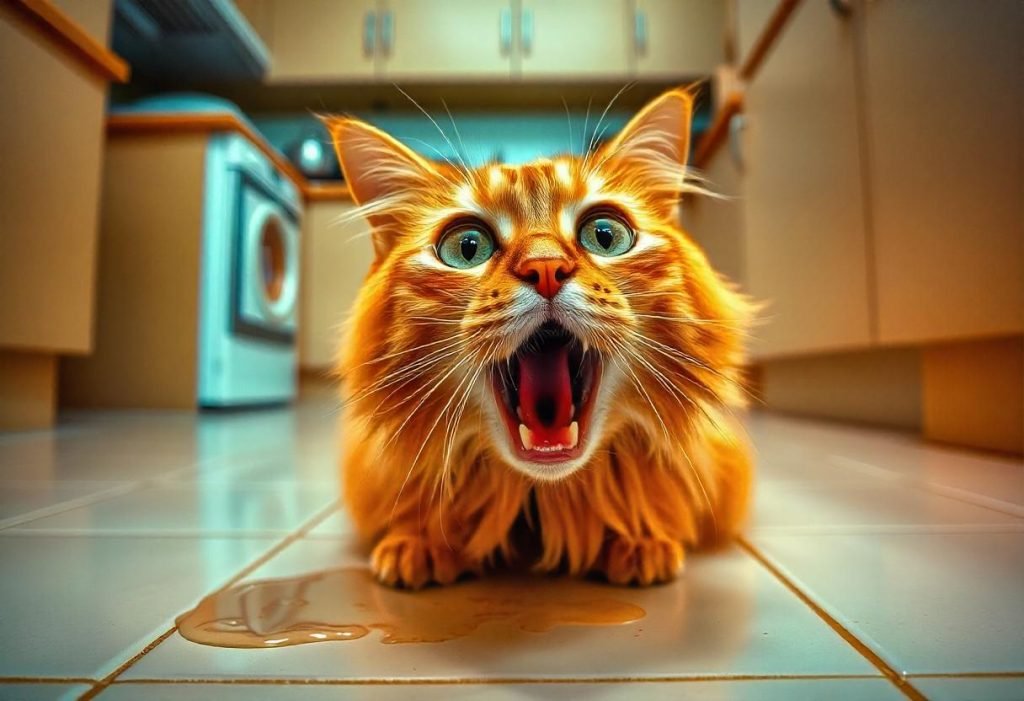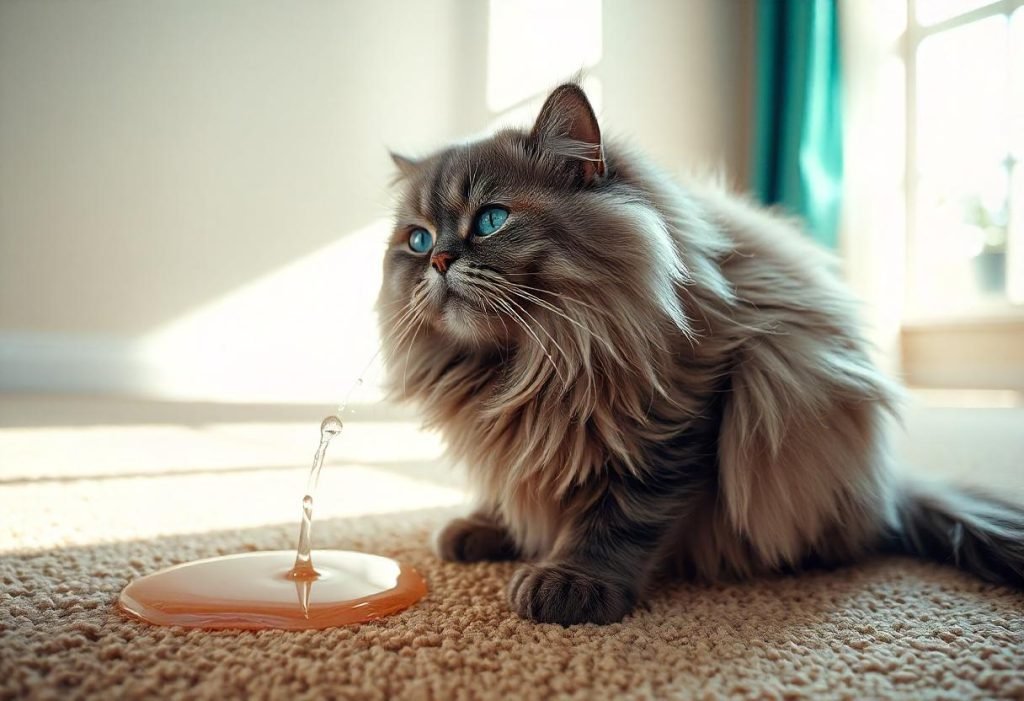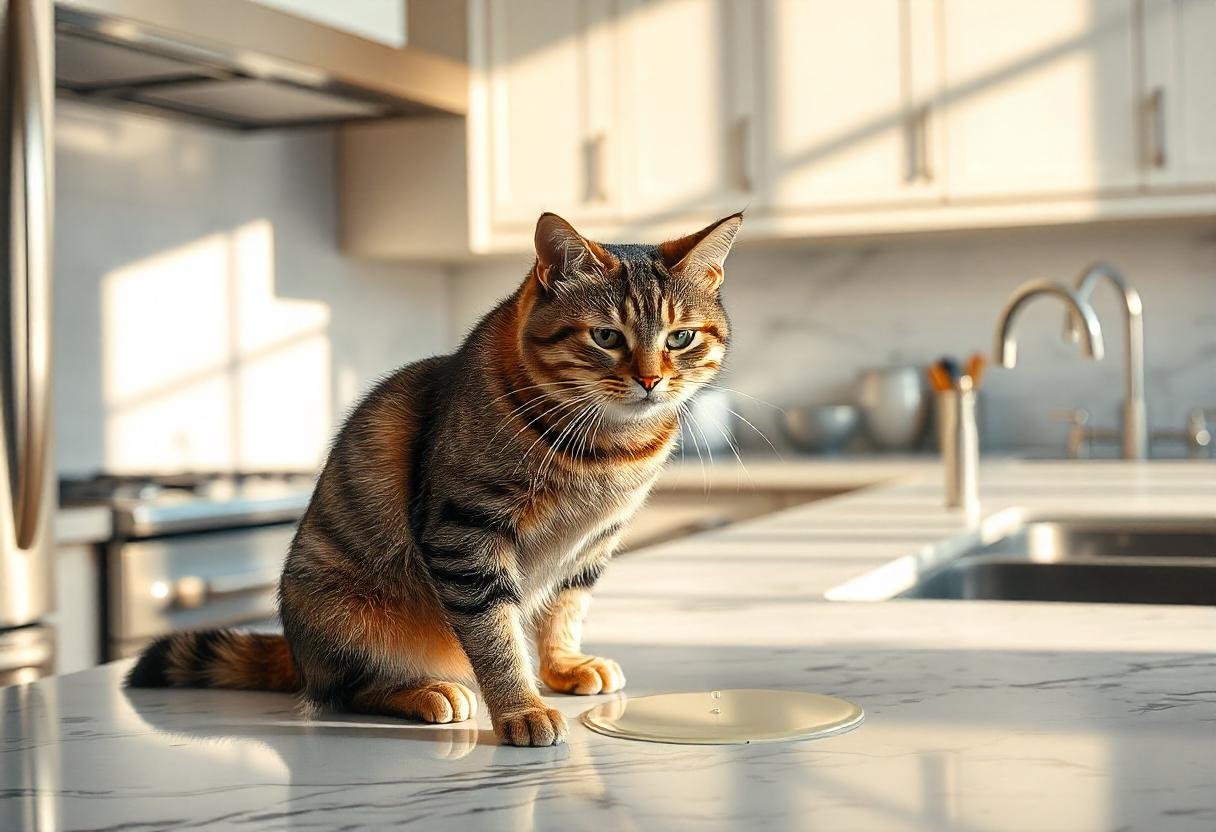The sight of your cat vomiting, especially when it’s clear liquid, can be a cause for concern, leaving you wondering why is my cat throwing up clear liquid and what’s causing this sudden discomfort.
While a single episode of clear vomiting might be a minor upset, recurring vomiting or clear vomit mixed with other substances like foam or bile, can be a sign of more serious issues.
This article dives into the world of feline vomiting, exploring the diverse range of causes behind clear liquid vomit, offering insights into potential complications, and guiding you towards effective solutions.
We’ll break down complex medical jargon into easy-to-understand language, using real-life case studies to illustrate the journey towards a happy, healthy, and vomit-free kitty.
Understanding Cat Vomit: A Closer Look
Imagine a forceful expulsion of stomach contents, often accompanied by gagging or retching.
This is the experience your cat might be going through when they vomit. Vomiting is a natural reflex designed to clear the stomach of irritants or harmful substances.
However, when vomiting becomes frequent or persistent, it’s a signal that something might be amiss.
1. Hairballs: A Common Culprit
Cats are meticulous groomers, and during this process, they often ingest loose hair, which can accumulate in their stomach and form hairballs.
When these hairballs become too large, they can trigger vomiting.
- Symptoms: Forceful vomiting, often of a hairball-like mass.
- Diagnosis: Based on the appearance of the vomit, which usually contains hair.
- Treatment: Regular brushing to minimize hair ingestion, hairball remedies, and sometimes dietary changes can help prevent hairballs.
Case Study: Charlie’s Hairball Mishap
Charlie, a 4-year-old tabby, was known for his meticulous grooming habits. He frequently vomited hairballs, often in a large, compacted mass.
His owner started brushing him more frequently, and Charlie’s hairball episodes decreased.
2. Gastrointestinal Upsets: Minor Irritations
Simple gastrointestinal upsets, often caused by changes in diet, eating too quickly, or ingesting something indigestible, can lead to vomiting, sometimes of clear liquid.
- Symptoms: Single episode of vomiting, sometimes with clear liquid, foam, or undigested food.
- Diagnosis: Based on the history of the event and often resolving within a few hours.
- Treatment: Withholding food for a few hours, followed by a bland diet, can help soothe the stomach.
Case Study: Lily’s Quick Eating
Lily, a 7-year-old Persian, was known for her enthusiastic eating habits. She often ate too quickly, which sometimes resulted in vomiting, including clear liquid.
Her owner encouraged her to eat slower, and Lily’s vomiting episodes decreased.

3. Food Allergies: Dietary Sensitivities
Food allergies, a common problem in cats, can trigger a range of symptoms, including vomiting.
- Symptoms: Vomiting, diarrhea, itchy skin, and possibly hair loss.
- Diagnosis: Based on clinical signs and possibly food elimination trials or allergy testing.
- Treatment: Switching to a hypoallergenic diet or eliminating the offending ingredient can help resolve symptoms.
Case Study: Max’s Food Allergy
Max, a 9-year-old Siamese, was vomiting frequently, often with clear liquid mixed with undigested food.
His veterinarian suspected a food allergy and recommended a hypoallergenic diet. After changing his diet, Max’s vomiting subsided.
4. Urinary Tract Infections (UTIs): An Unexpected Link
UTIs, while primarily affecting the urinary tract, can sometimes lead to vomiting in cats, potentially due to nausea or inflammation.
- Symptoms: Frequent urination, straining to urinate, blood in the urine, and sometimes vomiting.
- Diagnosis: Urine analysis to identify bacteria and inflammation.
- Treatment: Antibiotics to treat the infection.
Case Study: Oliver’s UTI and Vomiting
Oliver, a 12-year-old tabby, was vomiting clear liquid and seemed to be straining to urinate.
His veterinarian diagnosed a urinary tract infection and prescribed antibiotics. After a week of treatment, Oliver’s vomiting and urinary symptoms resolved.
5. Gastroenteritis: Inflammation of the Digestive Tract
Gastroenteritis, an inflammation of the stomach and intestines, can cause vomiting, often with clear liquid, foam, or bile.
- Symptoms: Vomiting, diarrhea, loss of appetite, and dehydration.
- Causes: Viral infections, bacterial infections, and parasites can cause gastroenteritis.
- Diagnosis: Based on clinical signs and possibly confirmed with diagnostic tests, such as fecal exams.
- Treatment: Supportive care, including hydration and sometimes medication, can help manage symptoms.
Case Study: Bella’s Viral Gastroenteritis
Bella, an 8-year-old Siamese, was vomiting clear liquid mixed with foam and had diarrhea.
Her veterinarian diagnosed viral gastroenteritis and recommended supportive care, including hydration and rest. After a few days, Bella’s symptoms subsided.

6. Pancreatitis: Inflammation of the Pancreas
Pancreatitis, an inflammation of the pancreas, can cause severe vomiting, often with clear liquid, and abdominal pain.
- Symptoms: Vomiting, abdominal pain, loss of appetite, and lethargy.
- Causes: High-fat meals, certain medications, and underlying conditions can trigger pancreatitis.
- Diagnosis: Blood tests, imaging studies, and sometimes biopsies can help diagnose pancreatitis.
- Treatment: Pain medication, fluid therapy, and nutritional support can help manage pancreatitis.
Case Study: Charlie’s Pancreatitis Diagnosis
Charlie, a 6-year-old tabby, was vomiting clear liquid, had severe abdominal pain, and seemed lethargic.
His veterinarian diagnosed pancreatitis and prescribed pain medication and fluid therapy. After several days of treatment, Charlie’s condition improved.
7. Liver Disease: Impacts on Digestion and Metabolism
Liver disease, a condition affecting the liver’s ability to filter toxins and regulate bodily functions, can lead to vomiting, sometimes with clear liquid.
- Symptoms: Vomiting, jaundice (yellowing of the skin and eyes), loss of appetite, and weight loss.
- Causes: Infections, toxins, and genetic disorders can cause liver disease.
- Diagnosis: Blood tests, imaging studies, and sometimes biopsies can help diagnose liver disease.
- Treatment: Depends on the cause and severity of the disease, and may include medications, dietary changes, and supportive care.
Case Study: Lily’s Liver Disease Diagnosis
Lily, a 4-year-old Persian, was vomiting clear liquid, had yellowing of the skin and eyes, and seemed lethargic.
Her veterinarian diagnosed liver disease and recommended a special diet and medication to manage her condition.
8. Kidney Disease: Disruptions in Fluid Balance
Kidney disease, a condition affecting the kidneys’ ability to filter waste products and regulate fluid balance, can lead to vomiting, sometimes with clear liquid, as well as other symptoms like increased thirst and urination.
- Symptoms: Vomiting, increased thirst, increased urination, lethargy, and loss of appetite.
- Causes: Infections, toxins, and genetic disorders can cause kidney disease.
- Diagnosis: Blood tests and urine analysis to assess kidney function.
- Treatment: Dietary changes, medication, and fluid therapy to manage kidney disease.
Case Study: Max’s Kidney Disease Diagnosis
Max, a 9-year-old Siamese, was vomiting clear liquid and seemed to be drinking and urinating more than usual.
His veterinarian diagnosed kidney disease and prescribed medication and dietary changes to manage his condition.
9. Toxins: Poisoning and Digestive Upsets
Ingesting toxins, like cleaning products, medications, or even certain plants, can trigger vomiting, sometimes with clear liquid.
- Symptoms: Vomiting, drooling, lethargy, diarrhea, and possibly seizures.
- Diagnosis: Based on history, physical exam, and possibly laboratory tests.
- Treatment: Depends on the type of toxin ingested and may include inducing vomiting, administering activated charcoal, or supportive care.
Case Study: Oliver’s Plant Poisoning
Oliver, a 12-year-old tabby, was vomiting clear liquid and seemed lethargic after chewing on a houseplant.
His owner rushed him to the veterinarian, who diagnosed plant poisoning and induced vomiting. After several hours of observation, Oliver recovered fully.
Decoding Your Cat’s Clear Vomit: Seeking the Source
When you notice your cat vomiting clear liquid, it’s crucial to determine the underlying cause to provide appropriate treatment.
Here’s how to approach the situation:
1. Observation: The Power of Careful Watching
- Vomiting frequency: Keep a log of your cat’s vomiting, noting how often they vomit, the appearance of the vomit (color, consistency), and any other symptoms.
- Other symptoms: Observe your cat for any other symptoms, such as lethargy, loss of appetite, diarrhea, increased thirst, or pain.
- Environmental factors: Consider any recent changes in your cat’s environment that could be causing stress or anxiety.
2. Veterinary Examination: Seeking Professional Guidance
- Physical examination: Your veterinarian will conduct a thorough physical exam, checking for any signs of illness or injury.
- Diagnostic tests: Depending on the suspected cause, your veterinarian may recommend bloodwork, fecal exams, urinalysis, radiographs (X-rays), or other diagnostic tests.
Treating Vomiting in Cats: A Tailored Approach
Treating vomiting in cats depends on the underlying cause, and your veterinarian will create a personalized treatment plan.
- Antibiotics: For bacterial infections, antibiotics are used to eliminate the bacteria causing the infection.
- Anti-emetics: To reduce nausea and vomiting, anti-emetics are often used to provide relief.
- Dietary changes: Switching to a bland diet or a prescription diet tailored to your cat’s needs can help soothe the stomach and prevent further vomiting.
- Hairball remedies: Hairball remedies, available in various forms, can help lubricate the digestive tract and prevent hairballs.
- Fluid therapy: Dehydration can be a serious consequence of vomiting. In severe cases, intravenous fluids may be necessary.
- Surgery: In rare cases, surgery may be required to address underlying issues, such as tumors or blockages.
Preventing Vomiting in Cats: A Proactive Approach
While vomiting can be a common occurrence in cats, there are steps you can take to minimize the risk of your cat experiencing these issues.
- Regular veterinary checkups: Yearly checkups can help identify early signs of illness and prevent complications.
- Dietary considerations: Provide a high-quality, nutritionally balanced diet that meets your cat’s specific needs.
- Avoid overfeeding: Don’t overfeed your cat, especially if they’re prone to vomiting.
- Hairball prevention: Regular brushing and hairball remedies can help minimize hair ingestion.
- Stress management: Create a calm and comfortable environment for your cat, minimizing disruptions and providing enrichment activities.
Conclusion: A Journey Towards a Healthy, Vomit-Free Cat
Seeing your cat vomit, particularly clear liquid, can be a cause for concern. Remember, understanding the root cause of your cat’s vomiting is crucial for effective treatment.
By observing your cat carefully, seeking professional help, and implementing appropriate management strategies, you can help your furry friend enjoy a healthy, comfortable, and vomit-free lifestyle.
Note: This article is for informational purposes only and should not be substituted for professional veterinary advice. Always consult with your veterinarian for a proper diagnosis and treatment plan for your cat’s specific needs.
